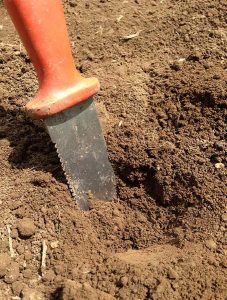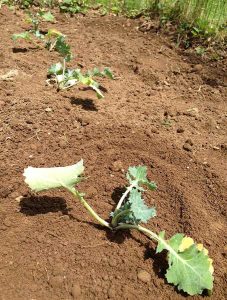Steps to Outdoor Planting: Gardening Basics
Everyone knows how to plant, right? Outdoor planting seems easy enough, however, I frequently see mistakes that end up in many a plant perishing. Sometimes our green friends get planted too deep, not deep enough, have poor soil, or many other mishaps and oversights.
 If it makes you feel any better, I have killed more than my fair share of plants. No worries- it’s how we all learn! Here are a few basic steps to help you on your way to green thumb glory.
If it makes you feel any better, I have killed more than my fair share of plants. No worries- it’s how we all learn! Here are a few basic steps to help you on your way to green thumb glory.
Digging the Hole
Easy enough right? Get your aggression out if you need to, this is a great time for that. For the best outdoor planting, dig a hole twice as big in diameter as the container your plant is currently in.
Disclaimer: Links below may contain affiliate links, which means we may get paid a commission at no additional cost to you if you purchase through this page. Read our full disclosure here.
I love a garden knife for this purpose. My old one has the orange handle pictured here, but I've since moved on to an Attican Hori Hori and love it.
Go ahead and go back to your mud pie days here, get your hands in the dirt! I’m not the only one right? Take the soil you dug from the hole and crumble it up finely so those new baby roots will grow with ease in the upcoming days.
This is the point where you should mix in any needed compost or soil amendments. Not sure if you need to add anything? Well, if your existing soil is pale, clumpy or hard to break up, your soil is probably in need of an amendment. This can be anything from your morning coffee grounds, broken up eggshells or bagged compost from the garden center.
If you don’t drink coffee, no worries! You can get used grounds from your local coffee house. Grab a few handfuls of your amendment of choice and mix it into the hole as well as the soil you removed from the hole.
Preparing the Plant
Squeeze the pot of your new plant and gently pull that baby out. This is the point where you’re going to think I’m crazy, but you need to loosen the roots of your new plant. I tend to cut, break or rip them apart in a few small sections around the root ball. You can also gently rake the roots if you’re uncomfortable with this, but I swear, they’ll be okay!
If you don’t break up the roots, they tend to continue growing right around in a circle just as if they were still in the pot. This critical step promotes new root growth and happy plants.
Check the Depth and Amend Soil
Check the depth at which you will place your plant. For outdoor planting especially, the top of the root ball should be flush with the existing soil. Add a little of your awesome newly  amended soil mix to the bottom of the hole to even that sucker up. Place your plant in the hole, keep it in place with one hand if needed and scoop the remaining soil in with your free hand. Compact the soil a bit to keep things stable. Double check that your plant is flush with the existing soil after compacting.
amended soil mix to the bottom of the hole to even that sucker up. Place your plant in the hole, keep it in place with one hand if needed and scoop the remaining soil in with your free hand. Compact the soil a bit to keep things stable. Double check that your plant is flush with the existing soil after compacting.
To Mulch or Not to Mulch?
Add a little mulch! This can be anything from store-bought bark mulch to shredded leaf litter or even shredded paper. Mulch helps to keep water in and weeds out. So handy! When adding mulch, only cover the surface of the soil directly over the root ball, but then add two inches around the perimeter for perennials and about three to four inches for shrubs and trees. Veggies aren’t as particular about mulch, but it does help to keep weeding to a minimum. If you are using mulch for your veggies, go light. Mulch depth for vegetables should only be about half an inch deep.
Watering
WATER! Yup, water that little guy in really well. Water thoroughly until it starts to run off, give it a minute to soak in, and then repeat this process a few times. New plants will need to be watered daily for the first week, then cut it back to every other day or so after that. You want to help it out in the beginning by not letting the soil dry out, but after the first week it’s important to let the surface of the soil dry out a bit before watering. Healthy roots need oxygen, so letting the surface dry sends a flush of oxygen to those roots to keep them healthy, fresh and white.
Too much water equals soggy, slimy roots, yellowing leaves and an unhealthy plant. It can take a full growing season for your outdoor plants to get established, so plan to water for the entire first season. This can mean one to three times a week depending on your area.
Enjoy
Enjoy the beauty!! Kick back and watch your new plants thrive.
I hope you have enormous success with your new plant friends. Keep in mind that this article is geared towards outdoor planting, but the only real difference for your indoor friends is to cut back on watering.
Remember that roots need oxygen just like you :).
I love the instant gratification and grounding that you get from planting. Gardening is a wonderful practice for being in the moment, so forget all of your concerns, get your hands dirty and marvel in the wonders of the green life.

Jennifer H
Thanks for the tips! It’s definitely trial and error, another thing I’m still learning is how much is too much sun / not enough sun? I’ve also made the mistake of over mulching one year – lessons learned!
Cheryl McColgan
Great point Jennifer! Maybe our Jen can follow-up with another post focused on sun/shade tips. Over the years it’s really been a lot of trial and error for me as well, but now that I have a lot less time to garden I find focusing on best practices is a good thing to maximize the time I do have!
Thanks so much for your comment.
Jennifer Mantle
Thanks Jennifer!! Working on more tips coming your way soon. Happy gardening!
Winter Gardening Tasks, Do These Before Spring for Success!
[…] in and the weather starts to turn, we can all be guilty of paying a little less attention to our beloved gardens. However, the autumn and winter months are a pivotal part of the gardening calendar. There are […]
Keto Mojito with Fresh Home Grown Mint and Keto Simple Syrup
[…] if you don’t have a green thumb, mint is so easy to grow. One important thing to keep in mind is that mint spreads like wildfire in […]